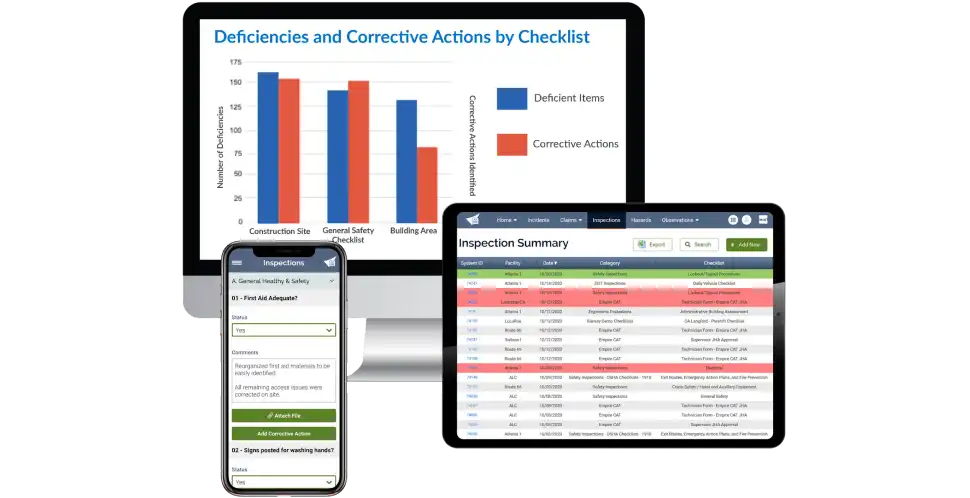March 31, 2025 9 min read

10 Reasons to Adopt an EHS Safety Audit Software
Industry:
Solution:

Health and safety in the workplace is crucial for protecting employees and minimizing risks. According to the U.S. Bureau of Labor Statistics, there were 2.7 million nonfatal workplace injuries and illnesses reported in 2020. Effective health and safety management not only safeguards workers but also helps organizations avoid costly fines, legal liabilities, and operational disruptions. Tracking, managing, and acting on incidents properly is key to creating a safer work environment and ensuring compliance with regulatory standards.
In an environment where safety regulations and workplace risks constantly evolve, it’s vital to have a system in place that can keep up. A comprehensive safety audit software simplifies this task by automating audits, providing real-time data, and helping organizations stay compliant. Let’s examine the top reasons why you should adopt safety audit software and share strategies for selecting the right tool to manage the well-being of your workforce.
Key Highlights:
- Streamline audits with pre-built safety checklists.
- Reduce administrative burden with real-time insights.
- Enhance compliance and reduce risks across multi-site operations.
What Is Health and Safety Audit Software?
Health and safety audit software is a tool that enables businesses to track, manage, and improve safety compliance. It offers a centralized platform for managing inspections, audits, and regulatory reporting, helping organizations ensure their operations meet industry standards and avoid risks.
Some of the biggest challenges involved in managing Environment, Health, and Safety (EHS) data are:
- Manual data collection: Gathering safety data manually is time-consuming, error-prone, and inefficient.
- Action tracking: Monitoring corrective actions can be complex without an automated system.
- Compliance visibility: Without a streamlined system, it’s difficult to track whether your organization is meeting compliance requirements.
- Audit scheduling: Scheduling audits and ensuring timely completion is a challenge without the right software.
- Program integration: Integrating safety data with other business systems can be cumbersome.
- Compliance gaps: Identifying gaps in safety protocols can be difficult without real-time data and reporting.
Simplify Safety Management with Vector EHS
Enhance workplace safety and compliance with features designed to save time and improve efficiency in your safety department.
Learn More
Top 10 Reasons to Implement EHS Audit Software for Your Workforce
1. Better Safety Inspections and Reports
Safety audit software significantly streamlines the inspection process, making it easier for safety teams to quickly identify and address potential hazards. With built-in templates and automated workflows, the software guides users through a standardized inspection process. This consistency ensures that all necessary data is captured every time, enhancing the reliability of the findings. Automated reporting simplifies data collection, eliminating the need for manual input, reducing the risk of errors, and speeding up the overall process.
Key benefits:
- Consistency: Ensures inspections follow the same process, leading to more reliable results.
- Faster Reporting: Automates the collection of necessary data, speeding up reporting.
- Improved Accuracy: Reduces human error, ensuring reports are comprehensive and actionable.
- Standardized Templates: Built-in templates for consistent inspections across locations.
2. Faster Hazard Detection and Prevention
One of the primary benefits of safety audit software is its ability to detect hazards before they happen. With real-time data collection, the software highlights potential safety risks across the workplace. This immediate visibility enables safety teams to take swift action, preventing hazards before they escalate into accidents or injuries.
Key benefits:
- Real-Time Data: Detect hazards as they arise, allowing for immediate action.
- Proactive Approach: Take action before risks escalate into incidents.
- Reduced Response Time: Faster hazard identification improves response time to threats.
- Predictive Alerts: Alerts that anticipate risks based on previous trends and data.
3. Enhanced Accessibility
Safety audit software enhances accessibility by allowing team members to access safety data and reports from anywhere, at any time. Whether in the office, on the go, or at a remote site, authorized users can easily review inspection data, incident reports, and audit results through cloud-based systems or mobile apps. This flexibility improves communication between teams and management, enabling better collaboration and decision-making.
Key benefits:
- Cloud-Based Access: Access safety data from any location or device.
- Mobile-Friendly: Mobile apps allow on-the-go access for real-time updates.
- Improved Collaboration: Easier communication between teams and management.
- Better Decision-Making: Instant access to data helps improve decision-making in real time.
4. Simplified Regulatory Compliance
Navigating complex safety regulations can be a daunting task for many organizations. Safety audit software simplifies this by automatically tracking and adapting to evolving regulations and industry standards. The software ensures that all safety requirements are aligned with current laws, such as OSHA’s Electronic Recordkeeping Requirements, removing manual tracking associated with compliance.
Key benefits:
- Automatic Updates: Tracks changes in regulations and automatically adapts.
- Efficient Documentation: Simplifies documentation and compliance record-keeping.
- Risk Reduction: Helps avoid fines or penalties by ensuring compliance with regulations.
- Regulation Mapping: Ensures audits are aligned with specific industry standards and laws.
5. Automated Task Management
Safety audit software automates many of the tedious, manual tasks associated with safety management. From scheduling inspections to assigning follow-up tasks, the software ensures that nothing falls through the cracks. Automated reminders and task tracking ensure that all safety audits and corrective actions are completed on time, reducing the chances of missed deadlines or overlooked safety issues.
Key benefits:
- Automated Reminders: Keeps safety teams on track with scheduled tasks and audits.
- Improved Efficiency: Reduces human error by automating routine tasks.
- On-Time Completion: Ensures tasks are completed on schedule with automated task tracking.
- Consistency: Streamlines safety processes across teams and locations.
6. Increased Safety Engagement
Safety audit software encourages greater involvement from employees at all levels of your organization. With user-friendly interfaces and mobile access, workers can easily participate in audits, report safety issues, and submit observations. This increased engagement fosters a culture of safety where everyone feels responsible for the health and safety of their colleagues.
Key benefits:
- Employee Engagement: Encourages workers to actively participate in audits and safety processes.
- Increased Awareness: Boosts safety awareness by involving all staff levels.
- Proactive Safety Culture: Encourages a team-oriented approach to hazard prevention.
- Real-Time Reporting: Employees can report hazards as soon as they are detected.
7. Integration Capabilities
Modern safety audit software integrates seamlessly with other systems, allowing for streamlined workflows across departments. By connecting with other safety related solutions such as a Leaning Management System (LMS), EHS software provides a unified view of organizational health and safety.
Key benefits:
- Seamless Integration: Works with other systems like an LMS.
- Unified Data: Combines data from different systems for a holistic view of safety.
- Improved Efficiency: Streamlines workflows and reporting across departments.
- Better Data Management: Enables data consistency and accuracy across systems.
8. Data-Driven Safety Insights
Safety audit software collects valuable data from inspections, audits, and incident reports that organizations can leverage for continuous improvement. By analyzing this data, businesses can identify patterns, track safety trends, and pinpoint areas that require attention.
Key benefits:
- Trend Analysis: Identifies recurring safety issues based on historical data.
- Targeted Interventions: Use data to develop focused strategies for improving safety.
- Real-Time Insights: Provides up-to-date information to act on safety risks.
- Continuous Improvement: Uses data to refine and improve safety protocols over time.
9. Reduced Administrative Burden
Manual safety audits and compliance tracking can be time-consuming and resource intensive. Safety audit software significantly reduces the administrative burden by automating many of these tasks. The software handles scheduling, data collection, reporting, and document management, freeing up valuable time for safety teams to focus on more strategic initiatives.
Key benefits:
- Time Savings: Reduces time spent on manual processes and paperwork.
- Lower Overhead: Less administrative effort required for task completion.
- More Strategic Focus: Allows safety teams to focus on higher-value tasks.
- Improved Efficiency: Cuts down on redundant or time-consuming tasks.
10. Easy Multi-Site Scaling
For organizations with multiple locations or facilities, scaling safety audits across sites can be a complex challenge. Safety audit software simplifies this process by providing a centralized platform that allows for uniform inspections and reporting across all locations.
Key benefits:
- Centralized Platform: Manage safety audits and reports from one central location.
- Uniformity Across Sites: Ensures consistent safety standards across all locations.
- Easier Scaling: Simplifies expansion of safety audits to additional sites or facilities.
- Cross-Site Reporting: Allows for consolidated reporting from multiple locations for easier analysis.
How to Select the Best Safety Software
When selecting the right safety audit software for your organization, follow these steps to ensure the software aligns with your needs:
- Assess Your Needs: Identify the specific requirements of your organization. Consider the size of your workforce, your regulatory environment, and the complexity of your safety programs.
- Shortlist Vendors: Research different software providers. Look for companies with a proven track record in safety management and software solutions tailored to your industry.
- Evaluate Costs: Compare pricing structures and assess the return on investment. Ensure the software is cost-effective and offers the features that match your needs.
- Involve Stakeholders: Engage with key stakeholders, including safety officers and IT professionals, to ensure the software meets technical and operational requirements.
- Plan Rollout: Create a plan for implementing the software. Ensure training is provided, and employees are ready to use the new system effectively.
EHS Software Guide
Review what EHS compliance software is, including must-have functionality, so you can make an informed buying decision.
Learn More
Streamline Environment, Health, and Safety Audits with Vector Solutions
Vector Solutions’ safety audit software streamlines your organization’s compliance and audit processes. With powerful reporting capabilities and actionable insights, our platform helps you proactively identify risks, track compliance, and maintain a safer work environment.
Book a demo today to see how our EHS audit software can transform your organization’s safety and compliance efforts.
Frequently Asked Questions
Q: How Often Do I Need to Conduct Safety Audits for My Organization?
A: The frequency of safety audits depends on your industry, but it’s generally recommended to conduct audits quarterly or biannually to maintain safety compliance and identify potential hazards.
Q: What Are the Advantages of Using Safety Management Software to Conduct an Audit?
A: Safety management software automates data collection, improves accuracy, ensures regulatory compliance, and provides real-time insights, making audits more efficient and comprehensive.
Q: What Are the Legal Implications of Health and Safety Auditing?
A: Health and safety auditing helps ensure compliance with workplace safety regulations. Failure to conduct audits can result in fines, legal liabilities, and increased workplace risks.









